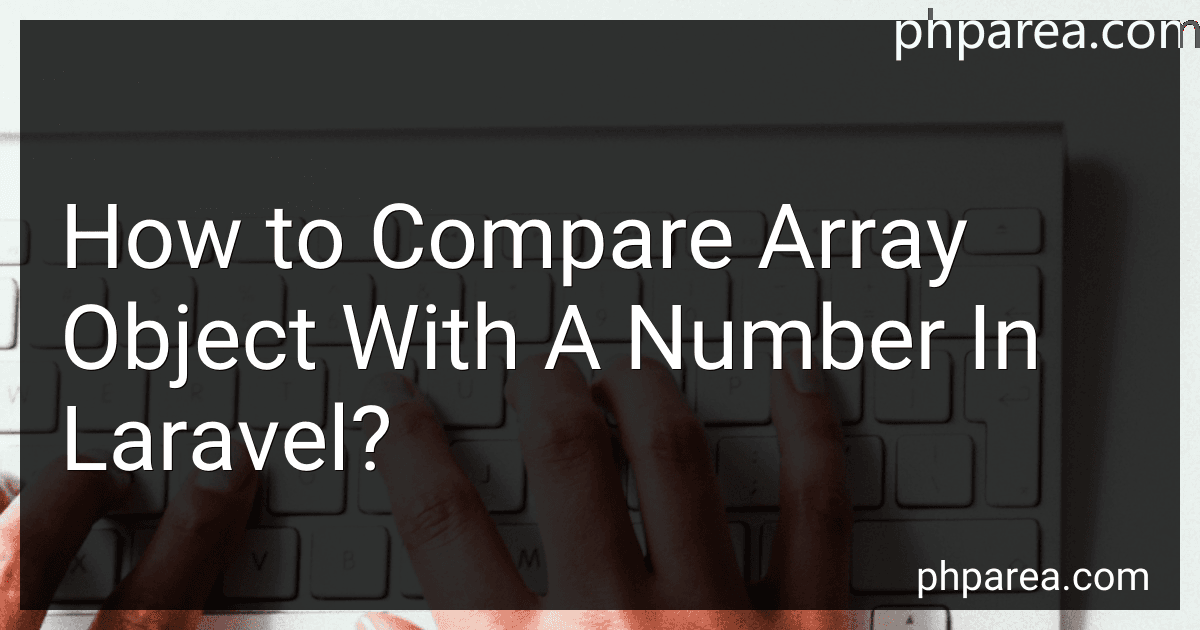Posts (page 18)
-
 5 min readTo show data of the current logged user in Laravel, you can use the Auth facade provided by Laravel. You can access the currently authenticated user using Auth::user() and then display the user's data as needed. For example, you can retrieve the user's name, email, or any other information stored in the user's database record. Make sure to have proper authentication set up in your application before attempting to access the current logged user's data.
5 min readTo show data of the current logged user in Laravel, you can use the Auth facade provided by Laravel. You can access the currently authenticated user using Auth::user() and then display the user's data as needed. For example, you can retrieve the user's name, email, or any other information stored in the user's database record. Make sure to have proper authentication set up in your application before attempting to access the current logged user's data.
-
 4 min readTo send a PUT request in Laravel, you can use the put method provided by Laravel's HTTP client (typically accessed through the Http facade).You will need to specify the URL you want to send the PUT request to, as well as any data you want to include in the request body. You can pass the data as an array to the put method.Here is an example of how you can send a PUT request in Laravel: $response = Http::put('https://example.
4 min readTo send a PUT request in Laravel, you can use the put method provided by Laravel's HTTP client (typically accessed through the Http facade).You will need to specify the URL you want to send the PUT request to, as well as any data you want to include in the request body. You can pass the data as an array to the put method.Here is an example of how you can send a PUT request in Laravel: $response = Http::put('https://example.
-
 3 min readTo change the date format in Laravel, you can use the format() method on a Carbon instance. Carbon is a date and time library that Laravel uses for working with dates.You can format a date like this: $date = Carbon::parse($yourDateVariable)->format('Y-m-d H:i:s'); In this example, Y-m-d H:i:s is the format you want to use. You can customize the format to get the desired output.You can also set the default date format for your application by modifying the AppServiceProvider.php file.
3 min readTo change the date format in Laravel, you can use the format() method on a Carbon instance. Carbon is a date and time library that Laravel uses for working with dates.You can format a date like this: $date = Carbon::parse($yourDateVariable)->format('Y-m-d H:i:s'); In this example, Y-m-d H:i:s is the format you want to use. You can customize the format to get the desired output.You can also set the default date format for your application by modifying the AppServiceProvider.php file.
-
 6 min readIn Laravel, you can compare an array object with a number by using the array_filter function and a callback function. First, use the array_filter function to iterate through the array object and pass a callback function that checks if each element in the array is equal to the number you want to compare it with. The callback function should return true if the element matches the number, otherwise return false. This will create a new array with only the elements that match the number.
6 min readIn Laravel, you can compare an array object with a number by using the array_filter function and a callback function. First, use the array_filter function to iterate through the array object and pass a callback function that checks if each element in the array is equal to the number you want to compare it with. The callback function should return true if the element matches the number, otherwise return false. This will create a new array with only the elements that match the number.
-
 6 min readTo execute complex MySQL queries in Laravel, you can use the query builder or Eloquent ORM provided by the Laravel framework.If you want to write raw MySQL queries, you can use the DB facade provided by Laravel. You can execute complex MySQL queries using the select, join, where, orderBy, groupBy, having, limit, and other query builder methods.You can also use the raw method provided by Laravel to write raw MySQL queries within the query builder.
6 min readTo execute complex MySQL queries in Laravel, you can use the query builder or Eloquent ORM provided by the Laravel framework.If you want to write raw MySQL queries, you can use the DB facade provided by Laravel. You can execute complex MySQL queries using the select, join, where, orderBy, groupBy, having, limit, and other query builder methods.You can also use the raw method provided by Laravel to write raw MySQL queries within the query builder.
-
 3 min readTo make a SOAP request in Laravel, you first need to install the PHP SoapClient extension. You can do this by running the following command in your terminal: sudo apt-get install php-soap After installing the extension, you can create a new SoapClient instance in your Laravel controller or any other class where you want to make the SOAP request. $client = new \SoapClient("http://example.com/soap.wsdl"); Next, you can call the SOAP methods using the SoapClient instance.
3 min readTo make a SOAP request in Laravel, you first need to install the PHP SoapClient extension. You can do this by running the following command in your terminal: sudo apt-get install php-soap After installing the extension, you can create a new SoapClient instance in your Laravel controller or any other class where you want to make the SOAP request. $client = new \SoapClient("http://example.com/soap.wsdl"); Next, you can call the SOAP methods using the SoapClient instance.
-
 5 min readTo use dd() without stopping the program in Laravel, you can use the dd() function along with the dd() method in the helpers.php file in your Laravel application. By wrapping the dd() function inside a condition, you can prevent it from stopping the execution of the program. This allows you to debug your code without interrupting the flow of the program. Additionally, you can also use the dump() function to display the result without stopping the program.
5 min readTo use dd() without stopping the program in Laravel, you can use the dd() function along with the dd() method in the helpers.php file in your Laravel application. By wrapping the dd() function inside a condition, you can prevent it from stopping the execution of the program. This allows you to debug your code without interrupting the flow of the program. Additionally, you can also use the dump() function to display the result without stopping the program.
-
 3 min readIn Laravel, you can pass objects to test methods by creating a new instance of the object and then passing it as an argument to the test method. This allows you to easily test the functionality of your application using different objects and scenarios. Additionally, you can use dependency injection to pass objects to your test methods, making your tests more flexible and robust.
3 min readIn Laravel, you can pass objects to test methods by creating a new instance of the object and then passing it as an argument to the test method. This allows you to easily test the functionality of your application using different objects and scenarios. Additionally, you can use dependency injection to pass objects to your test methods, making your tests more flexible and robust.
-
 4 min readIn Laravel, you can set the starting value of the primary key in your database table by defining a migration file and using the DB facade. Inside the up() method of the migration file, you can run a raw SQL query to set the primary key starting value.
4 min readIn Laravel, you can set the starting value of the primary key in your database table by defining a migration file and using the DB facade. Inside the up() method of the migration file, you can run a raw SQL query to set the primary key starting value.
-
 4 min readTo set cache control in Laravel, you can use the Cache facade provided by the framework. The Cache facade allows you to interact with the cache system in Laravel and set cache control headers.To set cache control in Laravel, you can use the cache() method on the Cache facade and pass in the key and value for the cache. You can also set the expiration time for the cached data by passing in a duration in minutes.
4 min readTo set cache control in Laravel, you can use the Cache facade provided by the framework. The Cache facade allows you to interact with the cache system in Laravel and set cache control headers.To set cache control in Laravel, you can use the cache() method on the Cache facade and pass in the key and value for the cache. You can also set the expiration time for the cached data by passing in a duration in minutes.
-
 5 min readIn Laravel, you can avoid nested forms by properly structuring your form fields and submissions. Instead of nesting forms within each other, you should separate your forms and handle their submissions separately. This can help prevent any conflicts or unexpected behavior that may occur with nested forms. Additionally, ensure that your form elements have unique names and ids to prevent any potential conflicts or issues when submitting the forms.
5 min readIn Laravel, you can avoid nested forms by properly structuring your form fields and submissions. Instead of nesting forms within each other, you should separate your forms and handle their submissions separately. This can help prevent any conflicts or unexpected behavior that may occur with nested forms. Additionally, ensure that your form elements have unique names and ids to prevent any potential conflicts or issues when submitting the forms.
-
 5 min readTo execute a DDL migration script in Laravel, you can create a new migration file using the artisan command php artisan make:migration. In this migration file, you can define the schema changes you want to make to your database using Laravel's schema builder methods.Once you have defined the schema changes in your migration file, you can execute the migration using the artisan command php artisan migrate.
5 min readTo execute a DDL migration script in Laravel, you can create a new migration file using the artisan command php artisan make:migration. In this migration file, you can define the schema changes you want to make to your database using Laravel's schema builder methods.Once you have defined the schema changes in your migration file, you can execute the migration using the artisan command php artisan migrate.